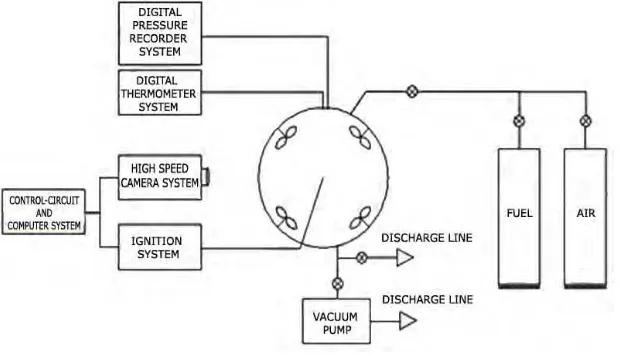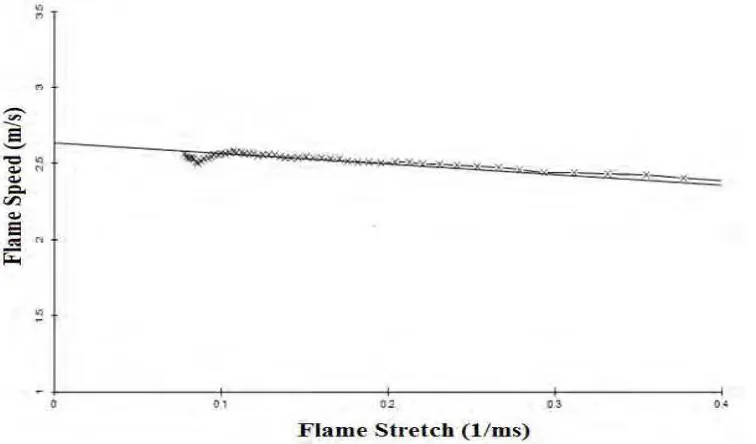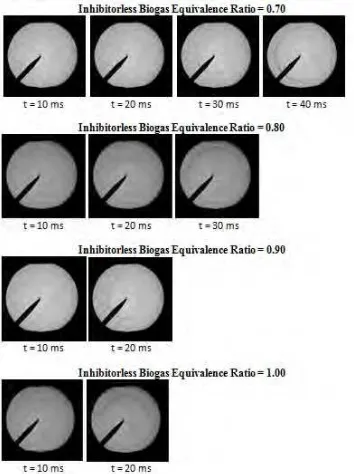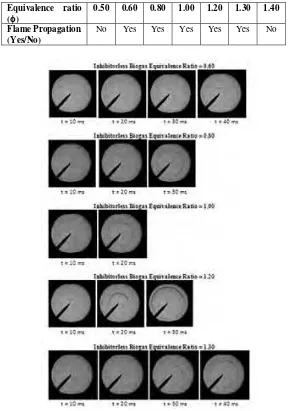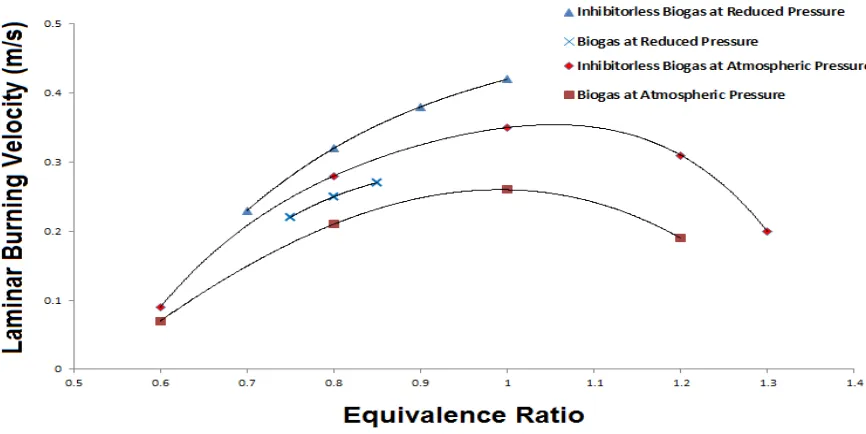Effect of Inhibitors on Biogas Laminar
Burning Velocity and Flammability Limits
in Spark Ignited Premix Combustion
Willyanto Anggono1, ING Wardana2, M. Lawes3, K. J. Hughes41
Mechanical Engineering Department, Petra Christian University, Surabaya, Indonesia. 2
Mechanical Engineering Department, Brawijaya University, Malang, Indonesia. 3
School of Mechanical Engineering, The University of Leeds, Leeds, England. 4
School of Process, Environmental and Materials Engineering, The University of Leeds, Leeds, England. 1
Abstract— Biogas is the natural byproduct of the decomposition of vegetation or animal manure, of which there are almost in exhaustable supplies in the world, and which does not contribute CO2 or other
greenhouse gases to global warming or climate change. Biogas contains 66.4% flammable gas (CH4) and
33.6% inhibitors (CO2 and N2). This study focuses on the effects of inhibitors on biogas laminar burning
velocity and flammability limits in spark ignited premix combustion. Spherically expanding laminar premixed flames, freely propagating from spark ignition sources in initially quiescent biogas–air mixtures, are continuously recorded by a high-speed digital camera. Initially, all the experiments in this paper were performed using inhibitorless biogas (biogas without inhibitors) at room temperature, at reduced pressure (0.5 atm) and at various equivalence ratios (ϕ) from the lower flammable limit to the upper flammable limit. The results are compared with those from biogas (containing inhibitors) flames at reduced pressure, inhibitorless biogas flames at atmospheric pressure (1 atm), and biogas flames at atmospheric pressure to emphasize the effect of inhibitors on biogas laminar burning velocity and flammability limits. Compared to an inhibitorless biogas-air mixtures, in the biogas-air mixtures, the presence of inhibitors cause a reduction in the laminar burning velocity and the flammable limits become narrower.
Keyword-Biogas, Inhibitor, Laminar burning velocity, Flammability limit, Premix combustion
I. INTRODUCTION
Biogas is the natural byproduct of the decomposition of vegetation or animal manure, of which there are almost in exhaustible supplies in the world, and which does not contribute CO2 or other greenhouse gases to global warming or climate change. It is, thus, eminently suitable as a green alternative to fossil fuels, which could help to reduce rising world temperatures. In addition, biogas can significantly improve rural economies, an important factor in poor developing countries. Biogas contains between 50-70% flammable gas (CH4) and 30-50% inhibitors (CO2 and N2), as well as small amounts of other gases and typically has a calorific value of 21-24 MJ/m3 and is a candidate in the search and development of sustainable green fuels. Additional benefits are its practicability and low construction costs, the necessary digestion facilities can quickly, easily and cheaply be constructed by unskilled local labour. Although to date research into biogas has had good results, if biogas is to become a major source of sustainable energy for the world, both its laminar burning velocity and flammability limits, as key parameters of any combustion mixture, requires further in depth investigation [1-16].
Flammability levels indicate biogas’s proportion of combustible gases and its limits. Gas mixtures consist of both combustibles, oxidizing and inert elements which are only combustible under certain conditions. The leanest ignitable flammable mixture is the lowest one, or the one with the smallest amount of combustible gases, likewise the richest flammable mixture has the highest flammable limit. Biogas differs from other hydrocarbon fuels in that studies have shown that the laminar burning velocity changes as a function of the equivalence ratio. The laminar burning velocity of rich biogas mixtures is lower than that of leaner ones. The laminar burning velocities of rich biogas air mixtures is less than those of lean mixtures which strengthens the finding that inhibitor gases have a greater effect on the laminar burning velocities in rich mixtures and corresponding lesser effect on lean mixtures due to the higher mole factor of these gases. This is so because the inhibitor in biogas not only dilutes the fuel mixture but also impedes the reaction as well as absorbing reaction heat which further reduces reaction rates. The effect of inhibitor is similar to that of high pressure, it raises the diffusion time and cuts short the reactant resident time or by reducing pressure when the thermal diffusivity of fuel mixtures is higher, which in turn should shorten reaction time [1-4].
not properly understood, this study looks into this matter with the aim of improving our knowledge of an important alternative and renewable energy source. This paper will examine the laminar burning velocity of biogas as well as its flammability limits and its findings compared to those without inhibitors and their dampening effect at both lower and ambient atmospheric pressures in order to highlight the effect of inhibitors on biogas laminar burning velocity and flammability limits in spark ignited premix combustion.
II. EXPERIMANTAL METHOD
Flammability limits indicate the levels of combustible gases in a mixture and their combustion levels. Gases can be mixtures of combustible, oxidizing as well as inert ones which can only ignite if certain conditions are fulfilled, the lowest limit is the leanest mixture that will ignite, i.e. that with smallest levels of combustible gases, whereas, the upper limit has the richest flammable limit. The generally accepted definition for laminar burning velocity is based on one dimensional, steady and unstretched flame. In this study, the laminar burning velocity of the premixed biogas combustion was measured in a high pressure fan-stirred combustion vessel. The schematic diagram of the experimental system is shown in Fig. 1 [1-4, 17-20]. Initially, all the experiments in this study where implemented at reduced pressure (0.5 atm) and with inhibitorless biogas at ambient temperatures and at various equivalent ratios (ϕ) from the lower to the higher flammable limits. The findings were compared with those from biogas (containing inhibitors) at lower (reduced) pressures, with inhibitorless gases at atmospheric pressure (1atm), and with biogas (containing inhibitors) at atmospheric pressure to highlight the effect of inhibitors on biogas laminar burning velocity and flammability limits.
Fig. 1. The Experiment Schematic Diagram
Fig. 3. Flame Radius as Function of Elapsed Time
The stretched flame velocity (Sn) can be derived from the flame radius versus time data as: Sn = dru/dt. The flame stretch rate α is defined as α = (2/ru)(dru/dt). A linear relationship between flame speed and the total stretch exists, and this is quantified by burned gas of Markstein length, Lb, and is defined at the radius, ru, such that: Sn–Ss = Lb α, where Ss is the unstretched flame speed, and is obtained as an intercept value of Sn at α = 0 in the plot of Sn against α. The measured flame speed against flame stretch rate for laminar flames is shown in Fig. 4. The unstretched laminar burning velocity (ul), was deduced from ul = Ss (ρb/ρu), where ρb is the density of the burned gas mixtures and ρu is the density of the unburned gas mixtures [1-4, 17-20].
Fig. 4. Flame Speed as Function of Flame Stretch
III.RESULTS AND DISCUSSION
A. Inhibitorless Biogas Laminar Burning Velocity and Flammability Limits at Reduced Pressure
Based on the results of the experiments at reduced pressure, inhibitorless biogas flame propagates from ϕ=0.70 till ϕ=1.00 as shown in Table I and Fig. 5. At ϕ≥1.20, the flame did not propagate because the combustion reaction was quenched by the larger mass of fuel. At ϕ≤0.60, the flame did not propagate either since reaction heat was insufficient to burn the mixtures.
TABLE I
Inhibitorless Biogas Experiment Results at Reduced Pressure
Equivalence ratio (ϕ)
0.50 0.60 0.70 0.80 0.90 1.00 1.20 1.40
Flame Propagation (Yes/No)
Fig. 5. Inhibitorless Biogas Flame Propagation at Reduced Pressure
Based on the experimental results and the calculations, as mentioned in the experimental method and in the previous studies [1-4, 17-20], the laminar burning velocities of inhibitorless biogas-air mixtures in premixed combustion at reduced pressure are 0.23 m/s for ϕ=0.70, 0.32 m/s for ϕ=0.80, 0.38 m/s for ϕ=0.90, and 0.42 m/s for ϕ=1.00 respectively.
B. Biogas (Containing Inhibitors) Laminar Burning Velocity and Flammability Limits at Reduced Pressure
The flames were propagated for lean (ϕ=0.75, ϕ=0.80, ϕ=0.85) biogas-air mixtures at reduced pressure as shown in Table II and these mixtures are the only biogas–air mixtures propagated at reduced pressure. The images obtained from the spherical flame propagation within the combustion bomb are shown in Fig. 6. At ϕ≥0.90, the flame did not propagate because the combustion reaction was quenched by the larger mass of fuel. At ϕ≤0.70, the flame did not propagate either as reaction the heat was insufficient to burn the mixtures [3].
TABLE II
Biogas Experiment Results at Reduced Pressure
Equivalence ratio (ϕ)
0.50 0.60 0.70 0.75 0.80 0.85 0.90 1.00 1.20 1.40
Flame Propagation (Yes/No)
No No No Yes Yes Yes No No No No
Based on the experimental results and the calculations, as mentioned in the experimental method and in the previous studies [1-4, 17-20], the laminar burning velocities of lean biogas-air mixtures in premixed combustion at reduced pressure are 0.22 m/s for ϕ=0.75, 0.25 m/s for ϕ=0.80 and 0.27 m/s for ϕ=0.85 respectively, which are in agreement with previous studies [1-4].
C. Inhibitorless Biogas Laminar Burning Velocity and Flammability Limits at Atmospheric Pressure
The inhibitorless biogas-air mixtures at atmospheric pressure were shown to have formed a propagating flame (0.60≤ϕ≤1.30), yet the extreme equivalence ratio (ϕ≤0.50 and ϕ ≥1.40) did not (see Table III). The engendering of laminar flames for inhibitorless biogas at atmospheric pressure is shown in Fig. 7.
TABLE III
Inhibitorless Biogas Experiment Results at Atmospheric Pressure
Equivalence ratio (ϕ)
0.50 0.60 0.80 1.00 1.20 1.30 1.40
Flame Propagation (Yes/No)
No Yes Yes Yes Yes Yes No
Fig. 7. Inhibitorless Biogas Flame Propagation at Atmospheric Pressure
The results of experiments: the above calculations and laminar burning velocity for the equivalence ratios of inhibitorless biogas-air mixtures [1-4, 17-20], enabled the laminar burning velocities to be found, namely, 0.09 m/s for lean (ϕ=0.60), 0.28 m/s for lean (ϕ=0.80), 0.35 m/s for stochiometic (ϕ=1.00), 0.31 m/s for rich (ϕ=1.20) and 0.20 m/s for rich (ϕ=1.30) inhibitorless biogas-air mixtures, which is in accordance with previous research [1-4].
D. Biogas (Containing Inhibitors) Laminar Burning Velocity and Flammability Limits at Atmospheric Pressure
TABLE IV
Biogas Experiment Results at Atmospheric Pressure
Equivalence ratio (ϕ)
0.50 0.60 0.80 1.00 1.20 1.30 1.40
Flame Propagation (Yes/No)
No Yes Yes Yes Yes No No
Fig. 8. Biogas Flame Propagation at Atmospheric Pressure
The results of the test and calculations from equations (see experiment methods) and the results from prior studies [1-4, 17-20], the laminar burning velocities of biogas-air mixtures in premixed combustion are 0.07 m/s for lean (ϕ=0.60), 0.21 m/s for lean (ϕ=0.80), 0.26 m/s for stoichiometric (ϕ=1.00) and 0.19 m/s for rich (ϕ=1.20) biogas-air mixtures, all of which concurs with past research [1-4].
E. Effect of Inhibitors on The Biogas Laminar Burning Velocity and Flammability Limits
For better understanding, the laminar burning velocities and flammability limits of inhibitorless biogas and biogas both at reduced pressure and atmospheric pressure are presented in Fig. 9.
The flame for inhibitorless biogas–air mixtures at atmospheric pressure can propagate between ϕ=0.60 and ϕ=1.30. Over ϕ=1.30, the flame are not propagate due to because the larger amount of fuel. At ϕ<0.60, the flames are extinguished as the reaction to the heat was not enough to consume the mixture. The flame for biogas-air mixtures at atmospheric pressure propagate over a smaller range, from ϕ=0.60 to ϕ=1.20. At ϕ>1.20, flames do not propagate as combustion is extinguished by the large mass of fuel, and a portion of the heat is taken up by the inhibitors, further strengthening the quenching effect. At ϕ<0.6, flames are unable to develop as the heat from the reaction is inadequate. Inhibitors (CO2 and N2) give rise to a loss in the laminar burning velocity due to the presence of inhibitors reduces the amount of combustible elements available for a given equivalence ratio, which leads to a lower overall chemical reaction rate in the bimolecular reactions in the fuel oxidation process, and these inhibitor gases take away some of the heat needed by the chemical reaction process. In rich biogas-air mixtures, inhibitor gases have a greater effect since these mixtures have a higher percentage of fuel [1-3].
At pressures lower than atmospheric ones, laminar burning velocities are higher. This is so because low pressure cuts the diffusion time and raises the resident times of the reactants or raises the thermal diffusivity and cuts the reaction time, and this raises the laminar burning velocity. This is the same for a higher laminar burning velocity at lower pressure. At lower pressures, inhibitorless biogas flame is engendered in a more limited equivalence ratio range, for example from ϕ=0.70 to ϕ=1.00. This is so because the fuel fraction is lower at low pressure, this results in lower reaction heat energy and is thus not enough to burn the fuel mass at ϕ<0.70. This also has a stronger quenching effect at ϕ>1.00. In biogas containing inhibitors flame propagation, the equivalence ratio range is very limited, namely from ϕ=0.75 to ϕ=0.85. This study found that the biogas diluted the fuel mixtures which obstructed a strong reaction and at the same time absorbed some of the heat from the reaction, which meant the reaction heat could only burn fuel mixtures within a limited range of equivalence ratios [3].
In conclusion, whereas reduced pressure raises the residence time of biogas this in turn increases the laminar burning velocity, yet the inhibitor gases weaken the reactant and also absorb some of the reaction heat which significantly limits flammability.
IV.CONCLUSION
In contrast to biogas without inhibitors, in biogas containing inhibitors (CO2 and N2), these contaminants give rise to a loss in laminar burning velocities. There are two causes of this, one dilutes the flammable portions in the fuel-air mixtures for a given equivalence ratio which induces a lower overall chemical reaction rate in the bimolecular reactions of the fuel oxidation process. In the other, the inhibitors in the biogas absorb some of the heat produced which lowers flame temperature, this tends to diminish the efficiency of some of the chemical reactions in the fuel oxidation process. At lower pressure, reactant diffusion time is reduced causing lengthen reactant resident time. As a result, laminar burning velocities are speeded up over those at atmospheric pressure. At lowered pressures, biogas fuel fraction is reduced, which in turn enhances the dilution effect of the inhibitors, making their impeding effect even stronger. Some of the heat energy from the reaction is also absorbed by them. All these effects cause the flammability limits to become much narrower at reduced pressure. Furthermore, the higher fractions of inhibitor gases in rich mixtures results in their having a greater effect on the biogas.
ACKNOWLEDGMENT
Many Thanks to Directorate General of Higher Education Republik Indonesia, Petra Christian University, Universitas Brawijaya (Slamet Wahyudi and Nurkholis Hamidi), Leeds University, (Prof. Pourkashanian, Prof. Derek Bradley, Prof. Mike Pilling), Akihiro Hayakawa (Japan) and Bambang Pudjianto (BBA Gas) for their support during this research.
REFERENCES
[1] Anggono W, Wardana ING, Lawes M, Hughes KJ, Wahyudi S, Hamidi N, “Laminar Burning Characteristics of Biogas-Air Mixtures in Spark Ignited Premix Combustion”, Journal of Applied Sciences Research, vol. 8, pp. 4126-4132, 2012.
[2] Anggono W, Wardana ING, Lawes M, Hughes KJ, Wahyudi S, Hamidi N, Hayakawa A, ”Laminar Burning Velocity and Flammability Characteristics of Biogas-Air Mixtures in Spark Ignited Premix Combustion”. Journal of Physics Conference Series, vol. 423, pp. 1-7, 2013.
[3] Anggono W, Wardana ING, Lawes M, Hughes KJ, Wahyudi S, Hamidi N. “Laminar Burning Velocity and Flammability Characteristics of Biogas in Spark Ignited Premix Combustion at Reduced Pressure”. International Journal Applied Mechanics and Materials, vol. 376, pp. 79-85, 2013.
[4] Anggono W, Wardana ING, Lawes M, Hughes KJ, Wahyudi S, Hamidi N, Hayakawa A, “ Experimental and Numerical Simulation on Boigas Flame Propagation Characteristic in Spark Ignition Premixed Combustion”, Proceeding The 3rd International Conference on Engineering and ICT (ICEI2012) Melaka-Malaysia, vol. 2, pp. 290-29, 2012.
[5] Cacua K, Amell A, Cadavid F, “Effects of oxygen enriched air on the operation and performance of a diesel-biogas dual fuel engine”. Biomass and Bioenergy, vol. 45, pp. 159-167, 2012.
[7] Ferrer I, Garfi M, Uggetti E, Marti LF, Calderon A, Velo E, “Biogas production in low-cost household digesters at the Peruvian Andes”, Biomas and Bioenergy, vol. 35, pp. 1668-1674, 2011.
[8] Bond T, Templeton MR, “History and future of domestic biogas plants in the developing world. Energy for Sustainable Development”, vol. 15, pp. 347–354, 2011.
[9] Ilminnafik N, Hamidi N, Wardana ING, “Behavior of flame propagation in LPG premixed combustion with carbon dioxide inhibitor”. International Journal of Academic Research, vol. 3, pp. 705-708, 2011.
[10] Lafay Y, Taupin B, Martins G, Cabot G, Renou B, Boukhalfa, “Experiment study of biogas combustion using a gas turbine configuration”, Experiments in Fluids, vol. 43, pp. 395-410, 2007.
[11] Nathan SS, Mallikarjuna JM, Ramesh A, “An experimental study of the biogas–diesel HCCI mode of engine operation”, Energy Conversion and Management, vol. 51, pp. 1347–1353, 2010.
[12] Porpatham E, Ramesh A, Nagalingam B, “Investigation on the effect of concentration of methane in biogas when used as a fuel for a spark ignition engine”, Fuel, vol. 87, pp. 1651-1659, 2008.
[13] Masera O, Edwards R, Arnez CA, Berrueta V, Johnson M, Bracho LR, Riojas-Rodríguez H, Smith, KR, “Impact of Patsari improved cookstoves on indoor air quality in Michoacán, Mexico”, Energy for Sustainable Development, vol. 11, pp. 45-56, 2007.
[14] Venkataraman C, Sagar AD, Habib G, Lam N, Smith KR, “The Indian National Initiative for Advanced Biomass Cookstoves: The benefits of clean combustion”, Energy for Sustainable Development, vol. 14, pp. 63-72, 2010.
[15] Alwis AD, “A review of Sri Lanka's performance with a renewable energy technology”, Energy for Sustainable Development, vol. 6, pp. 30-37, 2002.
[16] Kurchania AK, Panwar NL, Pagar. S.D, “Design and performance evaluation of biogas stove for community cooking application”, International Journal of Sustainable Energy, vol. 29, pp. 116-123, 2010.
[17] Gillespie L, Lawes M., Sheppard CGW, Woolley R, “Aspects of laminar and turbulent burning velocity relevant to SI engines”, SAE Paper Series 2000-01-0192, 2000.
[18] Gu XJ, Haq MZ, Lawes M, Wooley R, “Laminar burning velocity and Markstein lengths of methane-air mixtures”, Combustion and Flame, vol. 121, pp. 41-58, 2000.
[19] Bradley D, Hicks RA, Lawes M, Sheppard CGW, Wooley R, “The measurement of laminar burning velocities and Markstein numbers for isooctane-air and iso-octane-n-heptane-air mixtures at elevated temperatures and pressures in an explosion bomb”, Combustion and Flame, vol. 115, pp. 126-144, 1998.
